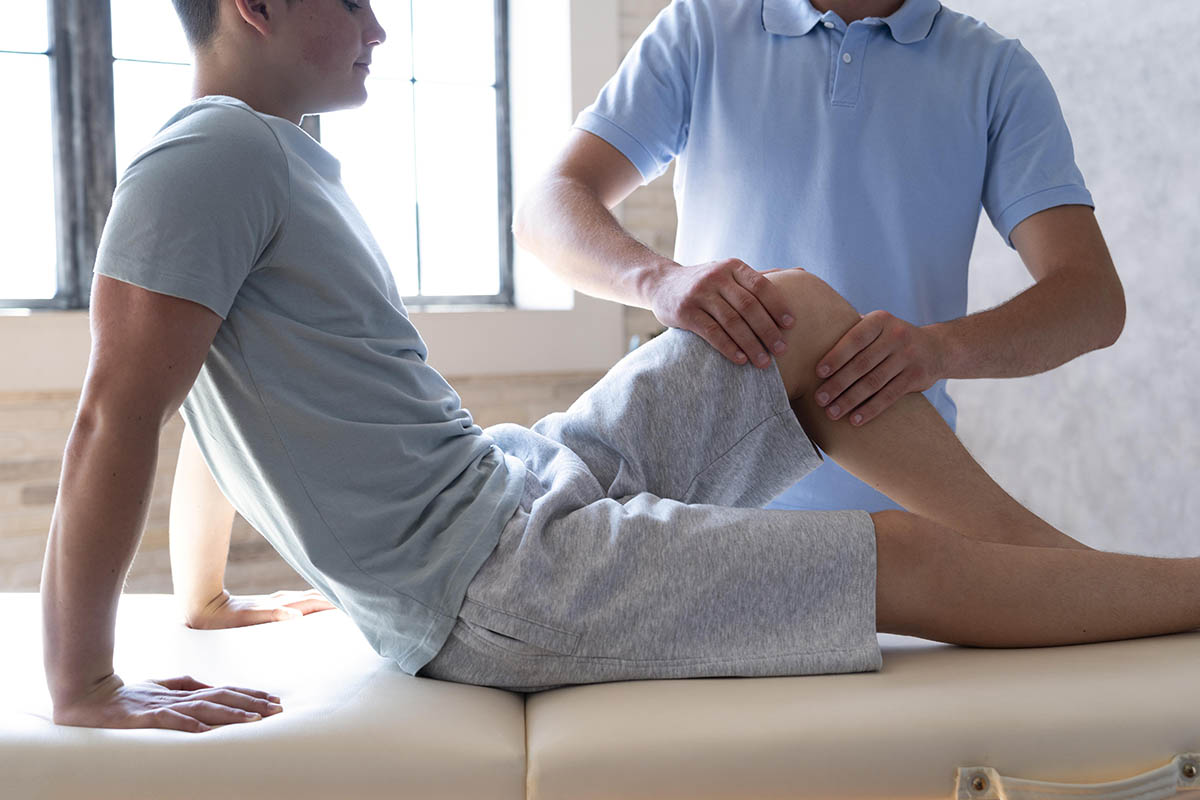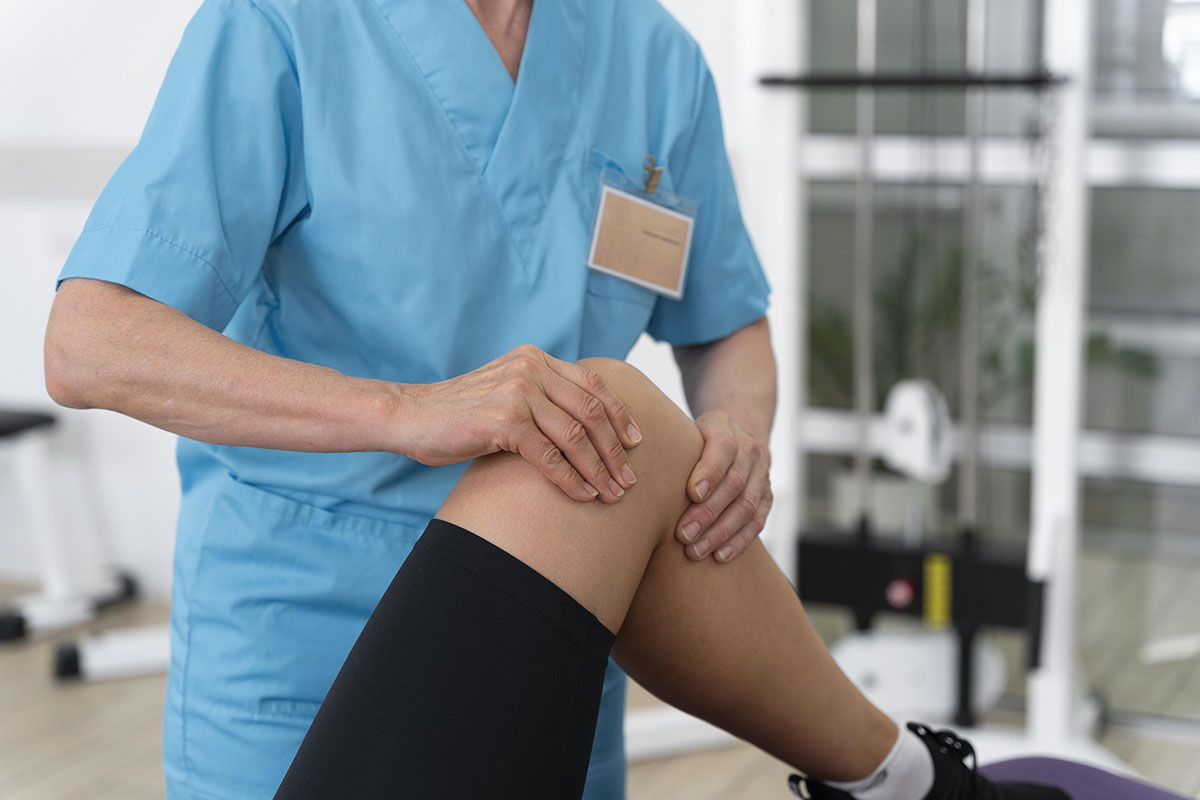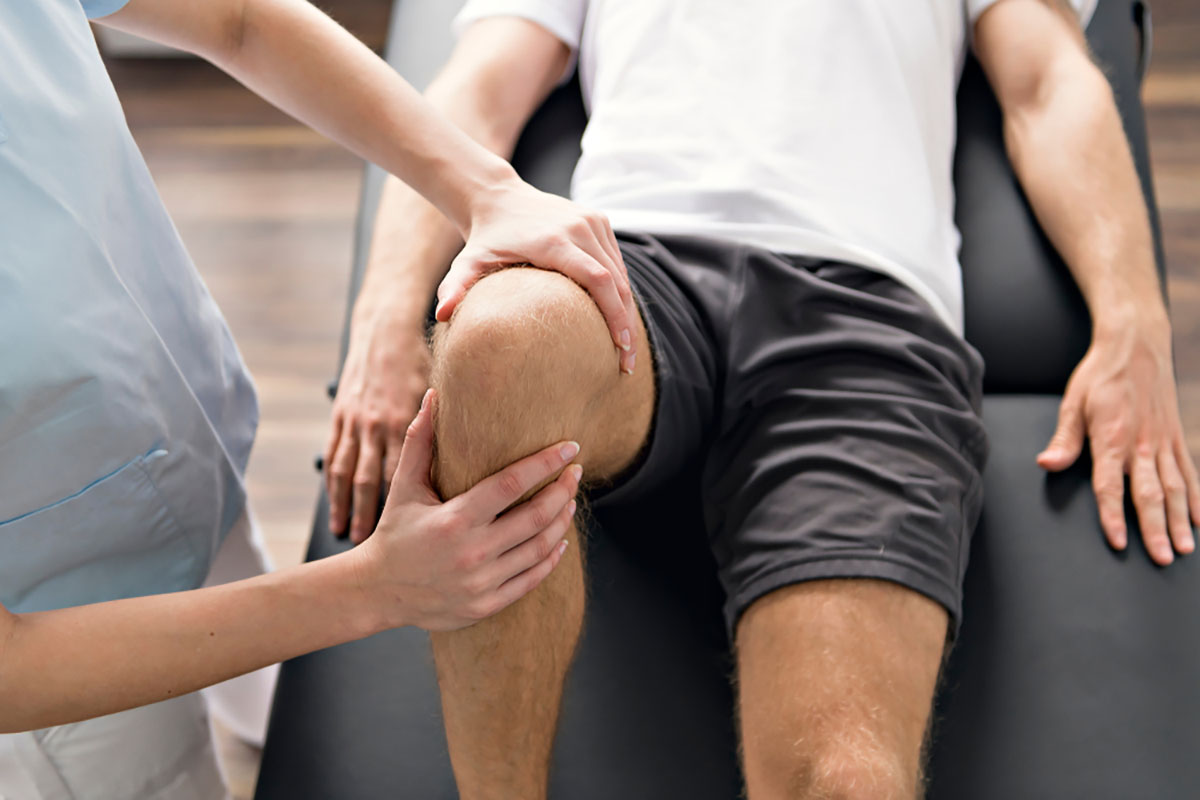Knee osteoarthritis, a prevalent and often debilitating condition, affects millions globally. This degenerative joint disease can cause knee pain, stiffness, and reduced mobility, significantly impacting daily life. While osteoarthritis has no cure, early intervention and effective management, such as physical therapy for knee arthritis, can slow its progression, alleviate symptoms, and help maintain an active lifestyle.
What is Knee Osteoarthritis?
Knee osteoarthritis arises when the protective cartilage within the knee joint gradually wears away, leading to bone-on-bone friction and inflammation. This results in knee arthritis pain, stiffness, swelling, and decreased range of motion, limiting one’s ability to perform everyday activities.
Causes and Risk Factors
Understanding the causes and risk factors associated with knee osteoarthritis is crucial for prevention and early intervention. While some factors, such as age and genetics, are beyond our control, others, like obesity and repetitive stress, can be modified to reduce the risk of developing or exacerbating this condition.
- Age: The risk of developing knee osteoarthritis escalates as the cartilage naturally deteriorates over time.
- Obesity: Excess weight is a significant risk factor for the development of osteoarthritis. Numerous population-based studies have consistently demonstrated a strong connection between being overweight or obese and the onset of knee osteoarthritis. Extra weight stresses the knee joints, accelerating cartilage breakdown and increasing the risk of developing osteoarthritis. Doing interventions for weight loss can significantly reduce this risk.
- Previous Injury: A history of knee injuries, such as ligament tears or fractures, can predispose individuals to osteoarthritis by disrupting the joint’s normal structure and function.
- Genetics: Some people may inherit a genetic predisposition to developing the condition, making them more susceptible to cartilage damage.
- Repetitive Stress: Occupations or activities involving repetitive knee bending or heavy lifting can increase the risk of osteoarthritis by placing excessive strain on the joint.
Symptoms and Progression
Recognizing the common symptoms of knee osteoarthritis is essential for seeking timely treatment and preventing further joint damage. The progression of the condition can vary among individuals, but early diagnosis and intervention can significantly improve outcomes and quality of life.
- Pain: Knee arthritis pain is the most common symptom, often worsening with activity and improving with rest.
- Stiffness: The knee may feel stiff, particularly morning stiffness or after inactivity, making it difficult to initiate movement.
- Swelling: Inflammation within the joint can cause swelling, leading to discomfort and limited mobility.
- Crepitus: A crackling or popping sensation may be felt or heard when moving the knee due to the rough surfaces rubbing against each other.
- Reduced Range of Motion: As the condition progresses, it may become challenging to fully bend or straighten the knee, impacting physical function and daily life.
Diagnosis of Knee Osteoarthritis
Diagnosing knee osteoarthritis typically involves a combination of a thorough medical history review, a physical examination to assess tenderness, swelling, and range of motion, and imaging tests, such as X-rays, to confirm the diagnosis and evaluate the severity of cartilage damage. This comprehensive approach helps healthcare providers make an accurate diagnosis and develop an appropriate treatment plan.
How Physical Therapy for Knee Osteoarthritis Can Help

Physical therapy for knee arthritis is a cornerstone of the management of knee osteoarthritis. Approximately 14 million people in the United States experience symptomatic knee osteoarthritis. This group includes nearly 2 million individuals under the age of 45 and 6 million between the ages of 45 and 64. This high number of individuals going through this condition highlights the need for a suitable and effective intervention such as physical therapy. A physical therapist will create a personalized treatment of the knee plan tailored to your specific needs and goals, focusing on improving joint function, reducing pain, and strengthening the muscles surrounding the knee.
Physical Therapy Techniques for Knee Osteoarthritis
Physical therapy employs a variety of techniques to address the unique needs of each patient with knee osteoarthritis. These techniques work synergistically to reduce joint pain, improve mobility, and enhance overall function, allowing individuals to regain control of their lives and engage in daily activities with greater ease.
Manual Therapy
Hands-on techniques, like joint mobilization and soft tissue massage, enhance joint mobility, reduce pain, and increase flexibility, helping to restore knee function.
Ultrasound
Therapeutic ultrasound employs sound waves to generate deep tissue heat, promoting blood flow, reducing inflammation, and aiding in pain reduction.
Electrical Stimulation
Electrical stimulation can alleviate pain and improve muscle function by stimulating nerves and muscles.
Targeted Flexibility Exercises
Gentle stretching exercises enhance range of motion and reduce joint stiffness, making movement easier and less painful.
Muscle Strengthening
Strengthening exercises target the muscles surrounding the knee, providing better support and stability to the joint, thus reducing stress on the cartilage and improving overall knee function.
Pain Management
Physical therapists educate patients on pain management techniques, such as relaxation exercises and proper body mechanics, empowering them to manage their symptoms effectively.
Benefits of Physical Therapy for Knee Osteoarthritis
The benefits of physical therapy for knee osteoarthritis are multifaceted, extending beyond pain reduction to encompass improved mobility, enhanced muscle strength, and a better overall quality of life. In recent years, physical therapy has increasingly been recommended as a non-drug treatment for osteoarthritis, largely due to its cost-effectiveness, convenience, and minimal side effects. When used alongside other treatments, physical therapy focuses on alleviating pain, enhancing joint function, and improving the overall quality of life for those living with osteoarthritis.
- Reduced Pain: Knee osteoarthritis physical therapy can significantly reduce knee arthritis pain and enhance overall function, allowing individuals to engage in daily life activities with greater ease.
- Improved Mobility: Increased range of motion and flexibility facilitate the performance of daily tasks and improve overall quality of life.
- Muscle Strengthening: Stronger muscles provide better support to the knee joint, reducing stress on the cartilage and potentially delaying the progression of osteoarthritis.
- Delayed Joint Replacement: In some cases, physical therapy for knee osteoarthritis may help delay or even eliminate the need for knee replacement surgery, offering a less invasive treatment option.
- Improved Quality of Life: By reducing pain, improving function, and promoting physical activity, physical therapy can significantly enhance the quality of life for people with arthritis.
10 Exercises for Knee Osteoarthritis
These physical therapy exercises for knee arthritis can help improve strength, flexibility, and range of motion. It is crucial to consult your physical therapist or healthcare provider before starting any new exercise program to ensure it is appropriate for your specific condition and needs.
- Quadriceps Sets: This exercise strengthens the front thigh muscles, which are crucial for knee stability and movement.
- Straight Leg Raises: This exercise strengthens the hip flexors and quadriceps while improving knee stability.
- Hamstring Sets: This exercise strengthens the back thigh muscles, which are important for knee flexion and stability.
- Calf Raises: This exercise strengthens the calf muscles, which contribute to ankle stability and can indirectly improve knee function.
- Wall Squats: This exercise strengthens the quadriceps, hamstrings, and glutes while promoting knee stability and improving range of motion.
- Step-Ups: This exercise strengthens the quadriceps, hamstrings, and glutes while improving balance and coordination.
- Side Leg Raises: This exercise strengthens the hip abductors, which contribute to hip stability and can indirectly improve knee function.
- Clams: This exercise strengthens the hip abductors and external rotators, which are important for hip stability and can indirectly improve knee function.
- Bridge: This exercise strengthens the glutes, hamstrings, and core muscles, which contribute to overall lower-body stability and can reduce stress on the knees.
- Stationary Bike: This low-impact exercise improves cardiovascular fitness and strengthens the muscles surrounding the knee without putting excessive stress on the joint.
How to Prevent Knee Osteoarthritis
Prevention plays a key role in managing knee osteoarthritis. By adopting healthy lifestyle habits and taking proactive measures, you can reduce your risk of developing this condition or slow its progression if you already have it.
Weight Management
Maintaining a healthy weight is crucial in reducing stress on the knee joints and minimizing the risk of developing or exacerbating osteoarthritis. Weight loss, even a small amount, can make a significant difference.
Lifestyle Modifications
Avoiding activities that put excessive stress on your knees, such as high-impact sports or repetitive kneeling, can help protect your joints.
Regular Movement and Exercises
Engaging in regular low-impact exercises like swimming, cycling, and walking strengthens the muscles supporting your knees, improves joint flexibility, and promotes overall health. Aerobic exercises can also be beneficial in managing weight and improving cardiovascular health.
How to Find the Right Physical Therapist for Knee Osteoarthritis

Choosing the right physical therapist is essential for achieving optimal outcomes in the treatment of knee osteoarthritis. A qualified and experienced therapist can tailor a treatment plan to your specific needs and guide you through the rehabilitation process, helping you manage pain, improve function, and regain control of your life.
- Ask for Referrals: Your doctor, friends, or family may recommend a qualified physical therapist with experience in treating knee osteoarthritis that will greatly help your healthcare decisions.
- Check Credentials: Ensure the physical therapist is licensed and has specialized training or certifications in orthopedics or sports medicine. A board-certified clinical specialist in orthopedics can provide expert care.
- Consider Specialization: Some physical therapists focus on specific areas, such as orthopedics or sports medicine, which may be beneficial for knee osteoarthritis treatment.
- Schedule a Consultation: Meet with the physical therapist or health care provider to discuss your needs, goals, and any concerns you may have. This will help you determine if they are the right fit for you and your treatment plan.
At Revival Physical Therapy, we specialize in delivering tailored care for knee osteoarthritis, focusing on restoring mobility and reducing pain. Our expert team in physical therapy Minneapolis is dedicated to helping you regain an active lifestyle through evidence-based treatments and personalized rehabilitation plans. Whether you’re seeking relief from chronic discomfort or aiming to enhance joint function, our approach emphasizes safeguarding your knees to ensure long-term joint health and vitality. Let us guide you through a journey to better knee health and a more active life.
Conclusion
Knee osteoarthritis can be a challenging condition, but with proactive management and appropriate interventions, individuals can effectively manage their symptoms and maintain an active lifestyle. Physical therapy for knee osteoarthritis plays a vital role in this process, providing a range of techniques and exercises aimed at improving joint function, reducing pain, and strengthening the muscles surrounding the knee. By working with a qualified physical therapist and adhering to their guidance, individuals can take control of their knee osteoarthritis and experience a significant improvement in their quality of life.
FAQs
Can physical therapy help knee osteoarthritis?
Yes, physical therapy for knee osteoarthritis is a highly effective treatment for this type of arthritis and is supported by scientific evidence and systematic reviews. It can reduce chronic knee pain, improve mobility, strengthen muscles, and potentially delay or eliminate the need for surgery, leading to improved physical function and quality of life for patients with chronic diseases like knee osteoarthritis.
Which is the best physical treatment for osteoarthritis?
The optimal physical treatment of osteoarthritis varies depending on the individual’s specific needs, goals, and the severity of their condition. However, evidence suggests that a combination of manual therapy, targeted exercises, and pain management techniques is often the most effective approach. Clinical practice guidelines recommend an individualized exercise program that includes a combination of strengthening, flexibility, and aerobic exercises. Additionally, modalities such as ultrasound and electrical stimulation may be used to manage chronic knee pain and inflammation.
How can I stop my knee arthritis from progressing?
Managing knee osteoarthritis, a common type of arthritis, involves several strategies to slow its progression and reduce symptoms. Key approaches include weight management, regular low-impact exercise like swimming and cycling, personalized physical therapy, and lifestyle modifications to avoid stress on the knees, which can lead to limited function. Medications, supplements, and assistive devices like canes or knee braces may also help manage pain and improve knee function. Working closely with a healthcare provider is essential for effective management of this chronic disease.


